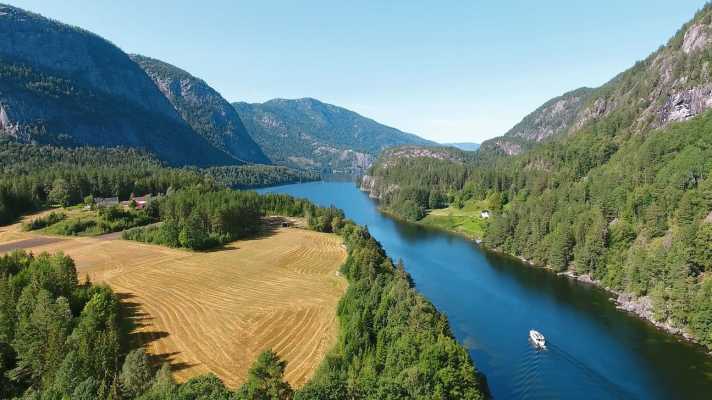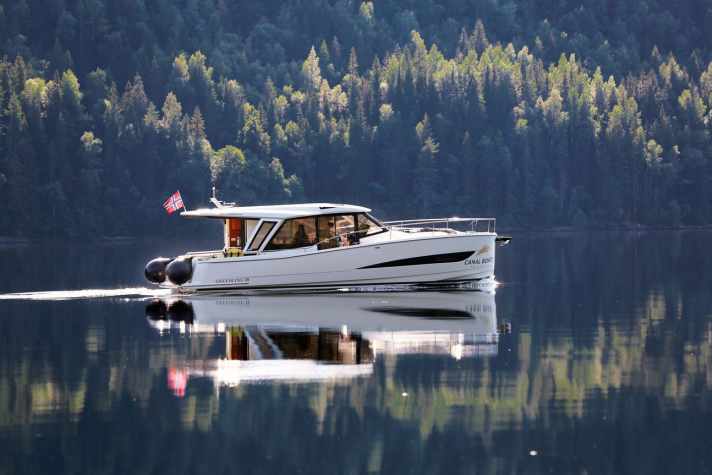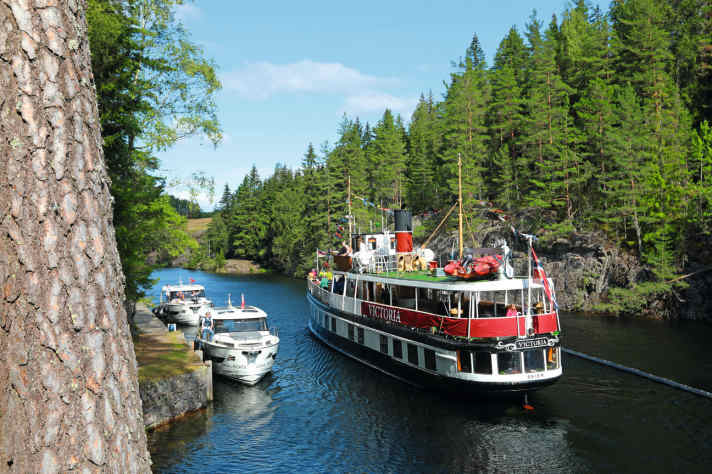




In the south of Norway, the Telemark Canal climbs inland via old lock stairs. We made the ascent - with Europe's first electric charter fleet
When the question of the most beautiful waterways in Europe comes up, the Dalsland Canal is usually high on the list, as is the Mecklenburg Lake District, of course, the Canal du Midi, the Norfolk Broads, the Caledonian Canal ... But there is one area that very few boaters have on their bucket list (or have ever heard of): the Telemark Canal in southern Norway. A waterway that leads from Dalen, 105 kilometres inland, through 18 locks and over 72 metres in altitude to the North Sea. Through a multitude of picturesque lakes, fairytale canals and manually operated locks with wooden gates. A canal system that was built between 1854 and 1892 to enable the transport of logs from the forests to the sawmills. A waterway that is diverse and impressive and is often referred to as the eighth wonder of the world for good reason.
Most people only get to know the canal from the roads or cycle paths. Until now, only locals have been able to experience it on their own keel - or those few who set off on their own keel or trailer. There has never been a charter base here because the Norwegian summer season is too short to be profitable. Or so it was always said.
Recently, however, it has become possible to sail the canal with a charter boat. The small company Canalboats Telemark has set up a fleet of two Greenline 33s and three Greenline 39s not far from the North Sea coast in Porsgrunn. A very special fleet, as the boats are all electrically powered. What still sounds like a dream of the future in Germany is easily possible in Norway thanks to the necessary infrastructure. In almost every harbour along the way, there are quick-charging stations that recharge the Greenline's 80 kW battery banks in just 2.5 hours. With the 50 kW drive, it is then possible to travel for eight hours every day at the five knots permitted on the canal before the next charge is required.
But why purely electric? Why here in Norway, where charter boats have been hard to come by until now? How is this suddenly profitable?
"Electric boats are simply the future," says fleet operator Nora Sjögren-Johre with conviction. "Especially here in Norway. Our electricity generation is based almost exclusively on renewable energies." Around 93.5 per cent of energy in Norway is generated by hydroelectric power plants, which are ubiquitous. "So it only makes sense to drive electrically. We think it's an innovative and sustainable concept. We drive completely environmentally friendly," she says.

But it is mid-August and we are the very last charter boat of the season. Next year, the canal will only be open to pleasure craft from 24 June to 18 August. How is it possible to keep the boats profitable? "Quite simply," says Sjögren-Johre, "the boats stay in the water all year round and are simply rented out as a floating hotel in the months when they can't sail. Who wouldn't want to stay in an unusual place on holiday?"
A well thought-out concept. But we have to get going, because it's a long way from the base in Porsgrunn to Dalen, and as we also have to cycle the route back afterwards, there's no time to lose. We want to cover a few more miles on the day we arrive.
Instruction is quick and uncomplicated. The boat starts like a computer by pressing an "on" switch. We don't need to check the oil or V-belt either. The fridge, microwave, induction hob and air conditioning work just like at home. Everything is deliberately kept simple, because after all, hotel guests should also be able to cope with it. Only charging needs to be explained: The quick-charging points deliver up to 63 amps of charging current from 400 volts, and the first plugging in of the heavy charging cable is done with a certain amount of respect. Heavy current on a floating dock, a strange feeling.
At first, it feels wrong to cast off the lines without hearing the familiar rumble of an exhaust pipe. But contrary to the expectation that the boat would immediately begin to drift, it moves forwards with a gentle push of the throttle, whirring quietly. After 7.5 kilometres, we reach the first lock at the end of the river at Skien, the official entrance to the Telemark Canal. We gently ascend five metres. As the steel lock gates buzz open, the canal appears surprisingly unspectacular: an industrial dock backdrop that only slowly changes. With every mile, it becomes a little greener, but also a little rockier on the banks. Then small hills rise up on both sides of the river, getting bigger and bigger, and we move out of the suburbs into the countryside, on a river through the middle of the mountains.
We have just become accustomed to the enormous scenery when a small "Sluse" sign points us on a new course up a narrow canal through barren, crushed and narrow concrete pillars. The map confirms that a hydroelectric power station would hinder our onward journey. We reach the Løveid lock, which leads us through three chambers in the middle of a mountain. Via a narrow canal carved into the rock, we finally reach the 13.6 kilometre long Lake Norsjø, on the upper third of which the small village of Ulefoss is our destination for the day. The berth at Gjestebrygge Ulefoss doesn't look at all inviting coming from the sea, as the harbour is located underneath a road bridge. But we have no choice, because we have accelerated a little too much on the big lake and the battery only shows 18 per cent after four hours of driving. So if you miscalculate on the longer routes, you're in trouble, because the boats have no generator and no reserve battery. An important lesson.

The marvellous view over the lake also inspired the Norwegian industrialist and founding father Niels Aall to have his summer residence built here. The Ulefoss Hovedgaard estate was inaugurated in 1807. And as Niels Aall was a good businessman and the large steelworks were only a kilometre downhill, he had the house built from slag, except for the twelve wooden pillars. The magnificent property, including the surrounding garden, is now managed by the Telemark Museum.
The Ulefoss lock is just around the corner. When the lock gates open, which are still made of roughly shod wood and are opened entirely by hand and with muscle power, it seems as if three chambers are not only leading us ten metres upwards, but also like a time machine into a bygone century.
From here, the canal looks almost as it did when the logs were floated down the canal from the mountains. The day's stage is relatively short, with only three hours of travelling time planned. But the ten lock chambers of the four locks Ulefoss, Eidsfoss, Vrangfoss and Lunde take up the whole afternoon. The time passes quickly, because locking the locks is a real experience. When the gates open, the water gushes into the basin.
Our destination for the day is reached behind the small lock in Lunde, and we moor with the stern to the charging station. The battery still shows 72 per cent, but spending an evening without a charging cable would be risky, especially as the next leg to Dalen is scheduled to take seven hours.
We have to pass through two more locks with three chambers the following day before we have free passage through the lakes Flåvatn, Kviteseidvatnet and Bandak. Once again, the landscape changes and the narrow canal becomes a river course, the river course becomes a fjord landscape. The route leads along high rock faces and green wooded slopes. Only a few holiday huts can be seen on the banks, which can only be reached by water with the rock face behind them. At the end of the Bandak, the mountain ranges on the starboard and port sides level out and form a valley in which the village of Dalen lies. From here, every road leads upwards.
Synne Aasland from the tourist office in Dalen greets us at the harbour and arranges to meet us early the next morning to visit a very special place: the small Rui homestead, where the two sisters Ingrine and Gurine lived, two well-known personalities throughout Norway. The once family of eight lived on a small terrace 200 metres above sea level in their own little cosmos. After four of the six siblings emigrated to America and their parents died, the eldest sisters Ingrine and Gurine lived alone until old age and had never left their farm. When the well-known journalist Knut Eidem visited them in the 1950s to write an article, he asked them whether there was any place that would appeal to them. "Yes, we would like to visit the king in his castle in Oslo," the two sisters jokingly admitted - and could hardly believe their eyes when they received an invitation a few weeks later. The king had read the newspaper article.

The ascent and descent over 1200 steps made us break out in a sweat. Just the right preparation for the next item on the programme: the Soria Moria sauna, which was built on a long jetty in shallow water directly out onto the Bandak. Rarely does a sauna offer such a panoramic view. And what could be more authentic than jumping into the ice-cold lake after sweating?
The schedule is a little tight, as a stop in the small town of Lårdal is planned for the evening. But it's only ten kilometres away, the batteries are fully charged and there's enough capacity to accelerate a little. So we take a short drive up the hairpin bends to the mountain in the north of the village to visit a genuine Norwegian stave church. The Vikings once built the wooden church in Eidsborg like a ship, with staves as frames and wooden panelling, painted with tar on the outside to preserve it. To this day, 28 such churches remain in Norway.
The journey to Lårdal is a pleasure, as there are no locks or battery capacities to restrict our speedy journey. In the marina, the owner of the small harbour restaurant welcomes us, collects the mooring fees and throws a couple of moose burgers on the grill. A delicacy.
We've been on our way back since Dalen and the route looks familiar. But it doesn't get boring travelling it a second time either. Once again, the stopover at the Lunde lock offers no sights. But such loading stops are just part of the "electric boat" experience.
The following day, we make a detour to the village of Gvarv in the north of Norsjø, where the world's northernmost winery is located - according to its own claims. But one kilometre further east, we are much more interested in Lindheim Ølkompani, because we have read that this small family business has not only been growing fruit for four generations, but has also been brewing beer and cider since 2013. Two dozen varieties are stored and matured in over 130 oak barrels. Too many to taste. However, the beautifully designed bottles also make a good souvenir.
On the last day of our journey, we have a manageable route with only two locks ahead of us. As the last gate opens, we can smell the salty air again. The sea is only a few kilometres away, but unfortunately so is the base, and the journey has come to an end. Wistful? Absolutely. The canal is without question one of the most beautiful waterways in Europe. Travelling this area by electric boat made the experience even more special.
What better way to round off an unforgettable week than with a sauna? The operators of the fleet have thought ahead and placed a sauna pontoon right next to the boats. It's the perfect place to look back on the Telemark Canal adventure through the steamed-up windows on the last evening. As a special highlight, the sauna has a floor hatch into the harbour basin. Anyone who takes the plunge will never forget the ice-cold water from the mountains.

